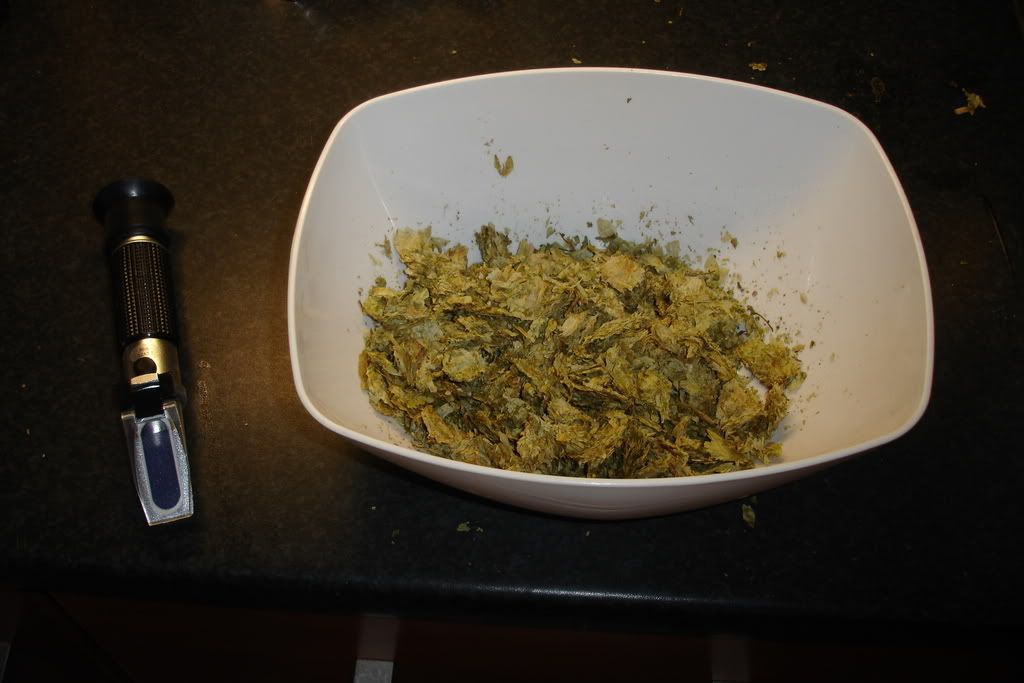 This will likely be the last beer I brew before my wedding as the next few weeks will be hectic what with wedding plans and brewing assignments. I planned a very straightforward ale today with only pale and crystal malt, but when I took a look through my supplies I spotted some biscuit malt, the presence of which had slipped my mind. I decided to add it to the grist for today's brew with the hope that it will provide a fuller malt aspect to the beer. Initial tasting of the sweet wort certainly suggests this will be a rich beer, so I hopped it quite well to balance the malt. This one should be English through and through because coupled with the English malts, I added a good measure of Challenger and Northdown along with a British ale yeast strain from Wyeast.
This will likely be the last beer I brew before my wedding as the next few weeks will be hectic what with wedding plans and brewing assignments. I planned a very straightforward ale today with only pale and crystal malt, but when I took a look through my supplies I spotted some biscuit malt, the presence of which had slipped my mind. I decided to add it to the grist for today's brew with the hope that it will provide a fuller malt aspect to the beer. Initial tasting of the sweet wort certainly suggests this will be a rich beer, so I hopped it quite well to balance the malt. This one should be English through and through because coupled with the English malts, I added a good measure of Challenger and Northdown along with a British ale yeast strain from Wyeast.My yeast propagation endeavours are working a treat, and saving me money which is an added perk. The plate stirrer method I employ for making starters is producing a vast mass of cells for pitching which enables me to make parallel starters by pouring off a few hundreds millilitres of starter into bottles and storing them in the fridge. These in turn can be used to make further starters thus enabling me to get a number of brews from one yeast pack. This only works up to a point because yeast don't really like sitting in an alcohol infused medium for too long and will start to mutate or just plain kick the bucket. A bit of reading around has suggested the little fellas will happily sit in the fridge for around 6 months before I have to start worrying about a detrimental drop in viability. There are quite a number of other methods to store yeast in the long term involving nutrient plates, slopes and deep freezing, but I'm not prepared to go down that route just yet. It isn't really necessary and the yeast cultures I used are commercially available and easily replaced. I suppose if I developed a particular house strain that I liked I could attempt to preserve it but that seems most unlikely from the home brew perspective.
6 comments:
"It isn't really necessary and the yeast cultures I used are commercially available and easily replaced" Its the only culture some brewers get.
Forgive the stupid question but what is the advantage of liquid yeast over dry yeast?
Some would say none at all, but the use of dried beer yeast is unusual in commercial breweries.
The classic exception in Ireland is Hooker which uses dry yeast and has very little yeast character. This is the main reason liquid strains are used; to add complexity. Hooker is excellent, but it is an ingredients driven beer with crisp hop and decent crystal malt. English ale just wouldn't be the same without the unique action of various yeast strains. Part of the problem is that not all yeast likes being dried down, otherwise I'm sure just about every liquid strain would be available dry for the handiness.
I definitely think it makes a difference, although some liquid yeasts have more of a wow factor than others.
We've kept ours in the fridge for around six months and it's still been viable. I'd like to get lots of yeast starters going but we've got limited space in our fridge, so we just tend to have one or two on the go at a time.
As you probably recall, n1mbus and I kept split starters (without the nice gadgets unfortunately) and trub material in bottles in my fridge for six month, and occasionally slightly longer, and they all worked out. Funnily enough, when we started brewing we only used liquid yeasts, but for the past year I'vv used nothing but dried yeast. In a way it makes sense for me, as it means that at least one ingredient is relatively constant, so I can see what effect the other ingredients have. Someday I'll do a mulligan porter with a few differet yeasts (once I settle on a Mulligan recipe that is :D)
I had you in mind when I was writing the post because I know you had done something similar.
The only difference appears to be that mine yeast stash stems from a starter and yours from the fermenter. I see it as an entirely viable means of stretching out a yeast pack as long as they aren't left to languish in the fridge for too long.
We did both actually, and in fact started off by making larger starters in a 5 litre demijohn and splitting that. Still counts as a fermenter I guess :D
It was only later as an experiment that we kept the crud from an ale brew and reused it a couple of months later for a porter, and it worked well. Definitely worth doing to save a few bob!
Post a Comment